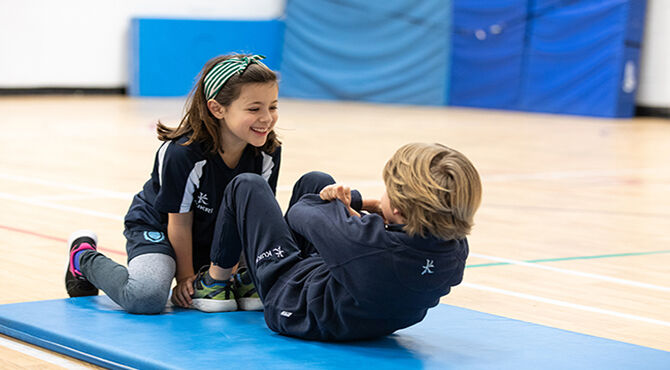Southbank International School’s view on remote learning
When the doors opened after lockdown, the entire school was abuzz with chatter, and not just from the students. Teachers shared their students’ excitement to be back. “Children have been so happy to see their friends and to see us again,” says David MacMorran, deputy principal for primary years.

No substitute for face to face teaching
When the doors opened after lockdown, the entire school was abuzz with chatter, and not just from the students. Teachers shared their students’ excitement to be back. “Children have been so happy to see their friends and to see us again,” says David MacMorran, deputy principal for primary years.While staff adapted to remote learning with imagination and dedication, it’s in the classrooms of Southbank International School where the magic happens. Small class sizes, a focus on good relations between staff and pupils and a strong sense of community means the school thrives on friendships and bonds. Teachers pride themselves on nurturing healthy debate and lively interaction - lessons are seldom dull.“There is no substitute for face-to-face teaching,” says Angela Johnson, head of English faculty in the senior school. “Body language speaks volumes. And we know how important spontaneous communication is - how students can just pop by and chat if they need to.” Doing all this from behind a computer is possible but more difficult, says head of languages, Fabienne Fontaine. In real life you can spot by the slump of shoulders or a tilt of a head whether a pupil has understood or not, and that’s harder online. “It’s about the relationships and the bond you manage to create with students.”Southbank is already equipped for future lockdowns
But should schools be forced to close again, Southbank is poised to switch seamlessly to online learning and knows how to structure a digital day. All the nuts and bolts are in place - every student is already equipped with a device, and the school has long been using the likes of Google Classroom to deliver resources and keep across individual student’s studies. “And we’ve streamlined the apps we use: we keep it simple and we know what works,” says Mr MacMorran.After playing around with digital format, teachers know how to help students remain engaged from their home classrooms. “Cameras on” is the first rule for Ms Fontaine - to keep as much open communication as possible - “it’s more polite,” she says. Students can still work in groups online with teachers “dropping in” on collaborative discussions. From podcasts to remote cookery classes, teachers have improvised with aplomb. Shyer students may have felt more able to contribute to online projects, teachers say. Digital tools have allowed teachers to differentiate more. Teachers realise too that students need unstructured time online to chat with each other.Remote learning has also forced teachers to rethink how students are assessed. And for skills-focused subjects such as English, this is critical, says Ms Johnson. “In my subject, we focus on the process - such as drafting and revision - rather than the end product. Students might see assessment as something that is ‘done to them’. As a school, we’re trying to change that perception and promote a growth mindset instead. And the detail you can go into with digital assessments has really helped that.”How to balance screen time
Online learning can be intense, and especially for young children, says Mr MacMorran - they need activities that bring them back to the “real” world and help them interact with their families. Some parents swear by a short trip to the park before the school day, work permitting. He recommends scheduling “non negotiable no-screen” time when the whole family can take a break together - mealtimes are an obvious opportunity. Board games, cookery classes, fancy dress meals, letter writing, photo shoots - try anything age appropriate that encourages family bonding.A routine that includes physical activity is critical, teachers say - and Southbank made this easier during lockdown with a livestreamed daily lunchtime session led by PE staff which saw everyone down tools and join in. Short breaks between on-screen lessons help refocus young minds - with a bounce on the trampoline for younger kids, juggling balls, hula hoops - try anything physical.How to prepare your child for online learning
Try to encourage your child - regardless of age - to take ownership of his or her learning, advises Mr MacMorran. “Ask what works best to help them learn.” Help them to plan their own day, and give them leeway when they’ve had enough, he advises. Children have different concentration time spans - remember in a normal lesson, just a short chunk of time is focused on “intensive” learning. Southbank encourages collaboration at school - wherever possible, try to support this to continue online.Silver linings
Lockdown has prompted teachers to review and adapt their teaching. “This is an opportunity to step back and reconsider our priorities,” says Ms Johnson. “National debate centres on what children have ‘lost’, but we need to consider skills they’ve gained. While many of our students are intrinsically motivated, for those who weren’t, it’s been a very positive time. I think they’ve been able to develop resilience.”While the school will do all it can to remain open, remote teaching has been a positive experience, says Mr MacMorran. “We want our children to be inquirers, thinkers and communicators - and be able to adapt. All of those skills came out online.”For more information visit the Southbank International School website©2025 Re:locate magazine, published by Profile Locations, Spray Hill, Hastings Road, Lamberhurst, Kent TN3 8JB. All rights reserved. This publication (or any part thereof) may not be reproduced in any form without the prior written permission of Profile Locations. Profile Locations accepts no liability for the accuracy of the contents or any opinions expressed herein.






































